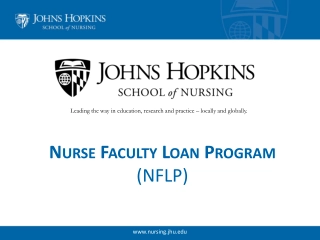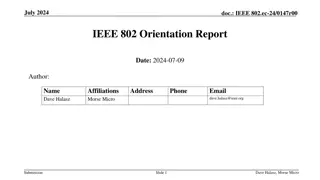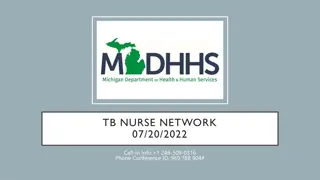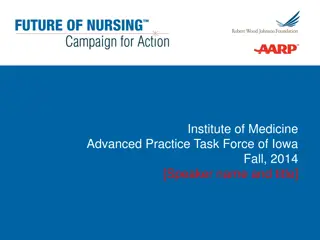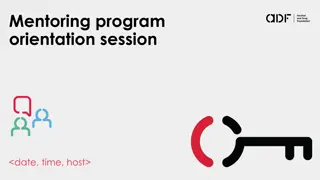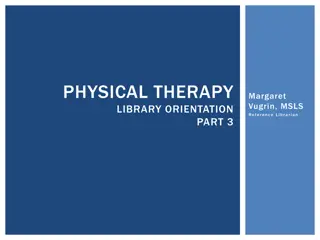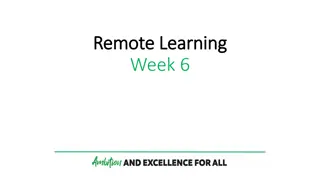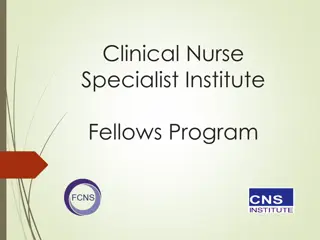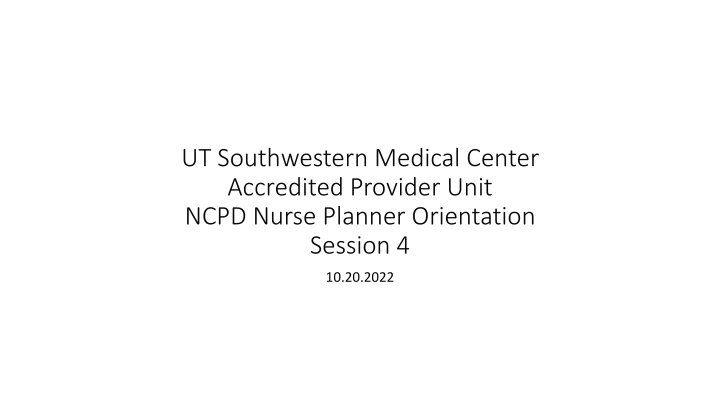
NCPD Nurse Planners Orientation Session at UT Southwestern Medical Center
"Join the accredited NCPD Nurse Planners Orientation Session at UT Southwestern Medical Center to enhance your professional practice. Learn about the Education Design Process, Planning Committee roles, and more. Elevate your knowledge and skills in nursing continuing professional development."
Download Presentation

Please find below an Image/Link to download the presentation.
The content on the website is provided AS IS for your information and personal use only. It may not be sold, licensed, or shared on other websites without obtaining consent from the author. If you encounter any issues during the download, it is possible that the publisher has removed the file from their server.
You are allowed to download the files provided on this website for personal or commercial use, subject to the condition that they are used lawfully. All files are the property of their respective owners.
The content on the website is provided AS IS for your information and personal use only. It may not be sold, licensed, or shared on other websites without obtaining consent from the author.
E N D
Presentation Transcript
UT Southwestern Medical Center Accredited Provider Unit NCPD Nurse Planner Orientation Session 4 10.20.2022
Disclosure to Learners UT Southwestern Medical Center is accredited as a provider of nursing continuing professional development by the American Nurses Credentialing Center s Commission on Accreditation. Relevant Financial Relationships: This is a non-clinical activity. Therefore, no relevant financial relationships with ineligible companies are needed for those involved with the ability to control the content of this activity. Requirements for successful completion: Attend the entire event Complete and submit the evaluation Learning Outcome: After participating in this activity, 75% of the learners who complete the evaluation will self-report an increase in knowledge and intent to change nurse planner practice regarding the topic covered. This activity provides 1.0 contact hour(s).
Recap Session 2 What do you recall from Session 2?
Recap Session 2 Education Design Process (EDP) Fundamentals of High-Quality EDP Current State Desired State Professional Practice Gap (PPG)
NCPD Design Process Components Needs Assessment Professional Practice Gap Planning Committee Underlying Education Needs Target Audience Learning Outcomes Content for NCPD Activity Active Learner Engagement Criteria for Awarding Contact Hours Evaluation Independence from Commercial Interest Organizations
Planning Committee Who is part of the planning committee? CEPD Nurse Planner Content Expert If CEPD Nurse Planner is also the content expert, another person needs to be on the planning committee
Planning Committee Keep it small In charge of needs assessment, design, development, implementation, and evaluation of activity Partners in completion of ANCC required forms Reviews Summative Evaluation results for any needed course changes
Underlying Education Needs Identify a professional practice gap Conduct a needs assessment determines the underlying NCPD needs of the target audience The Nurse Planner and Planning Committee evaluate what the target audience: does not know (knowledge deficit) does not know how to do (skill deficit) is not able to do in practice (practice deficit)
Evidence of a Professional Gap Survey data from stakeholders, target audience members, subject matter experts or similar Input from stakeholders such as learners, managers, or subject matter experts Evidence from quality studies and/or performance improvement activities to identify opportunities for improvement. Evaluation data from previous education activities Trends in literature Direct observation
Backward Activity Planning Backward-planning process to determine the NCPD needs and targeting the NCPD activity appropriately to address the gap. Determine desired learning outcome What is acceptable evidence Design and develop the activity content
Backward Activity Planning Backward Design Process (License CC 4.0 BY NC SA, Peter Mazohl, 2021)
Target Audience Determine who should receive the training Training is designed to meet the target population Needs to include nurses
Learning Outcomes Developed for the target audience What the learner will be able to do as a result of participating in the activity Must be observable and measurable Addresses the NCPD needs (knowledge, skills, and/or practices) that contribute to the professional practice gap (PPG) Should result in narrowing or closing the gap PPG
Learning Outcomes Current state of practice Change in practice Problem in practice Opportunity for improvement
Examples Nurses do not know how to perform a beside open chest procedure Nurses on 10G do not have the up to date transplant guidelines New oncology nurses are unable to administer chemotherapy
Learning Outcomes Desired state of practice What/how you want the learner to perform
Examples Nurses will know how to perform a beside open chest procedure Nurses on 10G will have the up to date transplant guidelines New oncology nurses are able to administer chemotherapy
Learning Outcomes What is the professional practice gap Evaluate the root causes of the gap, or why the gap exists
Examples Lack knowledge and skills regarding how to perform a beside open chest procedure Lack knowledge regarding the up to date transplant guidelines Lack knowledge, skills and performance to administer chemotherapy
Learning Outcomes Desired Learning Outcome What will the outcome be as a result of participation in this activity?
Examples Increased knowledge and skills regarding how to perform a beside open chest procedure Increased knowledge regarding the up to date transplant guidelines Increased knowledge, skills and performance to administer chemotherapy
Learning Outcomes Learning Outcome Measure Quantitative statement as to how the outcome will be measured
Examples After participating in this activity, 75% of the learners who complete the evaluation will self-report an increase in knowledge and skills regarding how to perform a beside open chest procedure knowledge regarding the up to date transplant guidelines knowledge, skills and performance to administer chemotherapy
Example - Knowledge After participating in this activity, 75% of the learners who completed the evaluation will self-report a change in knowledge and intent to change practice regarding the topic covered.
Example - Skill After participating in this activity, 75% of the learners who completed the evaluation will self-report a change in skill level and intent to change practice regarding the topic covered.
Example: Learning Outcome Measures Please provide examples of learning outcomes you have created in the past which were measurable.
Example: Learning Outcome Measures What changes would you make to your practice after receiving this information?
Wrap Up Discussion Questions Next Steps for Series Next Steps for receiving contact hours



